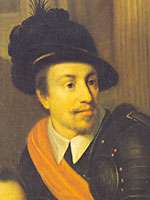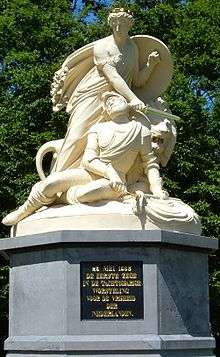Adolf of Nassau (1540–1568)

Adolf of Nassau (Dillenburg, 11 July 1540 – Heiligerlee, 23 May 1568) was a count of Nassau, also known as Adolphus of Nassau. He was the fourth son and sixth child of William I, Count of Nassau-Dillenburg and Juliana of Stolberg. He was the second youngest brother of William the Silent.
Life
He studied at Wittenberg and in 1566 fought against the Turks, then pushing into Europe. In 1568 his brother William the Silent took up arms against Philip II of Spain and Adolf fought beside him in Brabant. Adolf then joined the force under his brother Louis of Nassau in the north, where he died at the battle of Heiligerlee. The Spanish troops at Heiligerlee were commanded by Arenberg. Heiligerlee was a Dutch victory, but this was nullified when Alva beheaded counts Egmont and Horne in Brussels on 5 June 1568.
Death at Heiligerlee
The death of Adolf of Nassau is mentioned in the Dutch national anthem (4th verse):
- Graef Adolff is ghebleven, In Vriesland in den slaech,
- "Count Adolf stayed behind, in Friesland, in the battle"
The Graaf Adolfmonument

The first monument to Adolf was a simple truncated obelisk with an urn, created in 1826. It was poorly maintained and, by 1868, was badly deteriorated. That year, it was torn down and a contest was organized to design a replacement for Adolf's three-hundredth anniversary. The winning design was by the history painter J.H. Egenberger, in conjunction with Pieter Schenkenberg van Mierop (1837-1904), an architect who later emigrated to the United States. The design features a dying Adolf, protected by the Dutch Maiden.
The contract for executing the statue was given to the Belgian sculptor, Joseph Geefs. Originally, Van Mierop wanted the monument to be placed on a stone hill but, after some disagreement, Geefs designed an octagonal pedestal. The first foundation stone was laid on May 23, 1868, by William, Prince of Orange and Prince Henry. On the same day, five years later, the monument was unveiled by King William III.